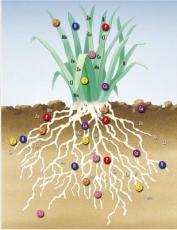Search
Login
Recommended
Fertilizing mistakes. Deficiency or excess of macro- and micronutrients
Noticing disturbing symptoms, such as spots on leaves, wilting or dysplasia, gardeners are sure that this is caused by a disease or pests, but there is another reason. Often the improper development of plants is associated with the introduction of mineral substances in excess or, conversely, if they are deficient, what fertilizers the plant needs to correct such errors, you will learn from this article.
Content
- Causes of Plant Nutrition Deficiency video
- Common mistakes video
- Nitrogen
- Phosphorus
- Potassium
- Calcium
- Magnesium
- Iron
- Boron and Molybdenum
- Manganese
Causes of Plant Nutrition Deficiency
Deficiency of macro- and micronutrients occurs even with proper plant nutrition. The causes of nutritional deficiency can be weather (heavy rains cause leaching of some substances to deeper layers of the soil) undesirable soil pH (for example, excessive acidity reduces the bioavailability of calcium and magnesium) damage to the root system by pests or when the soil is loosened.
Lack of nutrition may be the result of improper administration of one of the substances, so the excessive value of potassium complicates the availability of magnesium for plants. Deficiency or excess fertilizer for plants, fortunately, can be adjusted.
Common mistakes
The role of fertilizers in plant life is known to everyone, it is not only health for horticultural crops, but also a good harvest for a gardener. Unfortunately, fertilizers do not always give a positive result. How to use fertilizers correctly? Check out common mistakes:
- High dose of fertilizer - always follow the instructions of the fertilizer manufacturer, excess leads to poor consumption of other trace elements by the roots.
- Early or late fertilizer application - the timing of fertilizer application is different, for example, nitrogen fertilizer is applied only until mid-summer. High-speed fertilizers are applied (liquid) in mid-May, of slow action in April, organic fertilizers are recommended to be used in autumn.
- Use of expired fertilizers - after the expiration date, the beneficial properties of fertilizers become ineffective and toxic.
- Unequal distribution of fertilizing and fertilizing - watering or distribution of dry fertilizer should be uniform, this will help to avoid an excess or deficiency of minerals in different parts of the garden.
Nitrogen
The effect of fertilizers on plant growth is quite high, especially nitrogen shows this. With nitrogen deficiency, plants grow slowly, and the leaves turn yellow, some parts of the plants turn pink. Nitrogen fertilizers will replenish the deficit, depending on the need for soil acidification, ammonium sulfate (recommended for rhododendrons, azaleas, conifers and blueberries) or ammonium nitrate is used, liquid fertilizer from nettle is also suitable for this purpose, in addition to nitrogen, nettle will provide plants with potassium.

An excess of nitrogen, especially in combination with a lack of phosphorus, potassium and irrigation, is very dangerous, plants actively grow to the detriment of flowering and fruiting, in the autumn the plants weaken and become resistant to frost, considering all this, we note that nitrogen is fed only until July. The fight against excess nitrogen is good watering (water leaches nitrogen from the soil) and the application of phosphorus and potassium fertilizers.
Phosphorus
The demand for this component in plants increases during flowering and fruiting, phosphorus is also necessary for the development of the root system. If phosphorus deficiency is observed, plant growth slows down, leaves become hard and purple, plants bloom less.
Superphosphate will help eliminate the deficiency, but phosphorus uptake by plants is reduced on acidic soils while being applied with nitrogen fertilizers. The availability of phosphorus is poorly affected by a temperature below 13C and a pH level below 6-7 in these cases, it is absorbed only by 40%.
Excess phosphorus is almost impossible, more often gardeners complain of obvious signs of its lack.
Potassium
With potassium deficiency, the growth of the root system and shoots is suppressed, leaf chlorosis is observed, the edges of old leaves turn yellow at the edges, in advanced cases the plants wither, vegetable plants are deformed and lose their taste value. Potassium in the soil is easily supplemented with potassium sulfate.
Excess potassium interferes with the absorption of magnesium, impairs fruit storage and frost resistance of plants. Feeding plants with ammonium sulfate will help solve the problem of excess potassium.
Calcium
Calcium deficiency is manifested by withering of buds and tops of plants, deformation of young leaves, dry rot and curly leaves appear on tomatoes, the fruits of the apple tree are affected by dark spots. According to the erroneous opinion, the calcium deficiency is replenished with fertilizers for liming the soil, in fact, such fertilizers contain poorly soluble calcium compounds, usually calcium oxide or calcium carbonate. The role of these fertilizers is limited only by a decrease in soil acidity; calcium nitrate is used to eliminate calcium deficiency.
Excess calcium is often observed when irrigating with hard water, which leads to chlorosis, a lack of boron, magnesium, potassium and phosphorus, and their additional introduction is required here.
Magnesium
Magnesium deficiency is characterized by wilting and chlorosis of leaves, especially coniferous trees and shrubs. Sometimes, due to a lack of magnesium, flowering of plants is delayed, necrosis is possible, early falling of leaves. Solves the problem of magnesium sulfate deficiency. An excess of potassium is indicated by signs of calcium deficiency, as potassium makes it difficult for calcium to reach the roots.

Iron
Iron deficiency in its features is very similar to magnesium deficiency, the difference is that chlorosis appears only on young leaves. A decrease in the amount of iron in the soil is observed after liming, at high soil pH and a weak supply of oxygen in the root zone.
An iron chelate is recommended as a source of iron for garden plants. Excess iron is unlikely, symptoms - chlorosis, passing into necrosis, slow growth of shoots and roots.
Boron and Molybdenum
With a deficiency of these trace elements, leaf chlorosis is observed, beets can die, and sunflower can not give seeds. Boron prevents excess calcium, improves the flow of nitrogen, phosphorus, potassium and magnesium to the roots. Boron content will increase - boric acid.
Molybdenum is involved in the transformation of nitrogen, highly in demand by leguminous plants, tomatoes, cabbage and lettuce.

Manganese
Manganese is an activator of almost all processes in plant life and is urgently needed during the growing season. Manganese deficiency interferes with the normal growth and development of plants, leads to the emergence of many diseases, the first signs of deficiency are chlorosis, and then leaf necrosis. Make up for the deficiency of manganese sulfate.





